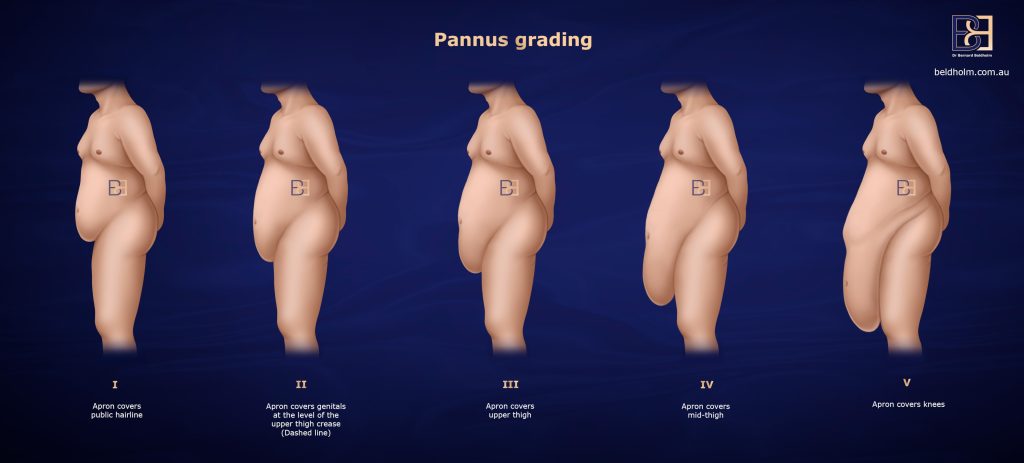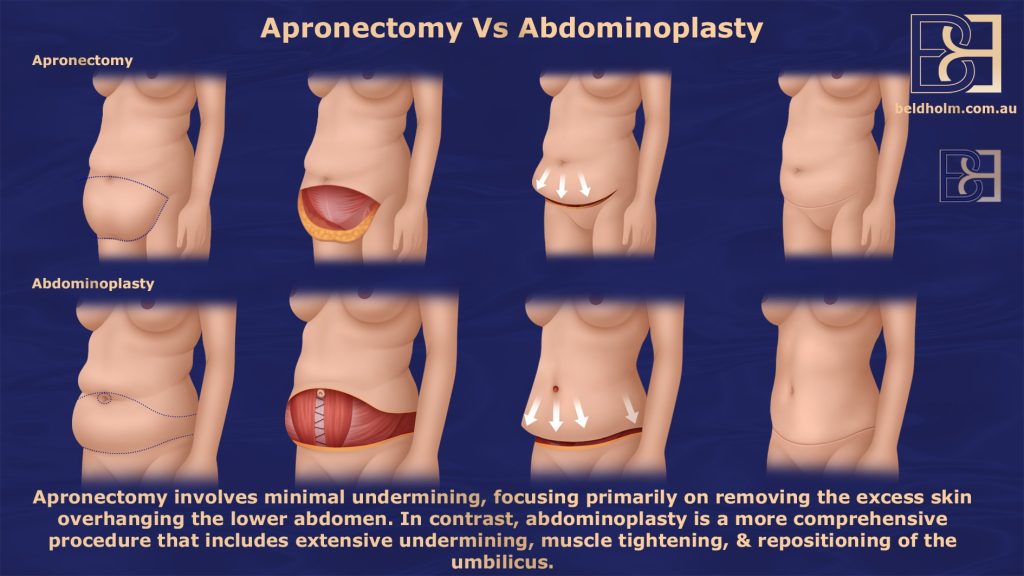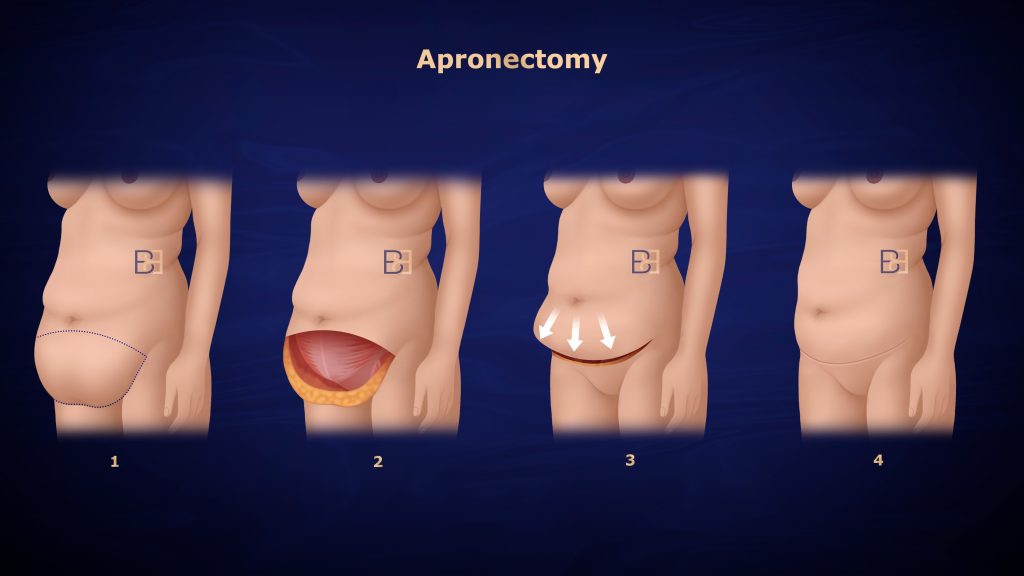Apronectomy Post Weight Loss in Newcastle, Maitland & Hunter Valley, Australia
Book Online NowIn Dr. Beldholm’s experience, apronectomy is typically not the first procedure considered for loose skin on the abdomen. For many patients, more comprehensive procedures like Fleur de Lis or extended abdominoplasty are often better options, as they focus on excess skin across a larger area of the abdomen and provide more dramatic results.
Apronectomy specifically targets the loose skin in the lower abdomen, with minimal undermining required. The procedure focuses solely on excising the “apron” of excess skin that hangs over the lower abdomen, without the extensive muscle tightening or more complex skin removal seen in other body contouring procedures.
This procedure is generally less invasive, making it a good option for patients who may want to take a staged approach to body contouring. It can be used as an initial procedure to remove significant amounts of excess skin, with the option to progress to more advanced procedures like Fleur de Lis or extended abdominoplasty at a later stage for further refinement.
What is Apronectomy?

Apronectomy is a surgical procedure designed to remove excess abdominal skin. This excess skin, often referred to as an “apron,” can hang down over the lower abdomen, causing both physical discomfort and aesthetic concerns. The primary goal of apronectomy surgery is to eliminate this excess hanging tissue.
The need for an apronectomy often arises after significant weight loss. When individuals lose a substantial amount of weight, the skin may not retract back to its previous shape, leading to an overhang of skin that can be cumbersome and unsightly. This procedure is especially advantageous for those who have undergone bariatric surgery or have achieved significant weight loss through diet and exercise.
Beyond aesthetics, apronectomy treats excess skin that can cause chafing, rashes, and other skin irritations, making daily activities a challenge. Removing this skin allows individuals to enjoy a more comfortable and active lifestyle, free from the physical burdens that excess skin can impose.
Benefits of Apronectomy
The benefits of the apronectomy procedure extend far beyond the obvious. Here are some of the primary advantages:
- Hygiene
- Reduction of skin irritations and infections
- Comfort
The removal of excess skin can alleviate the physical limitations that hinder mobility, allowing individuals to partake in physical activities they previously avoided.

Apronectomy vs. Abdominoplasty
The key difference between apronectomy and abdominoplasty lies in the extent of undermining and the potential for additional intra-abdominal procedures. An apronectomy focuses solely on removing the hanging skin in the lower abdomen, with minimal to no undermining. As such, it does not treat issues like diastasis recti (separation of abdominal muscles) or hernias that may be present higher in the abdomen. This makes apronectomy advantageous for patients with significant medical issues or those seeking a less invasive option.
In contrast, abdominoplasty (including Fleur de Lis abdominoplasty) involves more extensive undermining of the abdominal tissue, allowing for the removal of more skin and the ability to repair underlying issues such as diastasis recti and hernias. This procedure provides a more comprehensive and refined result but requires a longer operation time and a more involved recovery.
While apronectomy is typically faster and less complex, abdominoplasty offers a more thorough approach for patients seeking significant reconstructive body surgery and the repair of abdominal wall defects.
Who is an Ideal Candidate for Apronectomy?
Dr. Beldholm does not consider apronectomy to be a highly effective procedure due to its limited applicability and the modest results it provides. The amount of skin that can be removed is restricted, and the overall outcome is less comprehensive compared to other procedures. In most cases, extended abdominoplasty or Fleur de Lis abdominoplasty are far better options, as these procedures focus on both the lower abdominal apron and any vertical or horizontal excess skin, offering more substantial results.
In Dr. Beldholm’s view, apronectomy is primarily suitable as a staging procedure for patients who have not yet reached their ideal weight but are experiencing significant functional issues due to the excess skin. Additionally, apronectomy may be considered for patients with significant medical issues for whom a longer, more invasive procedure would pose risks. In such cases, the apronectomy can help increase comfort without the need for a prolonged surgery.

The Apronectomy Procedure
The apronectomy procedure is performed under general anaesthesia.
The excess hanging skin is carefully marked and then excised with minimal undermining. Unlike abdominoplasty, which involves extensive undermining, apronectomy focuses solely on the lower abdomen with minimal tissue disruption. Additionally, the umbilicus is not repositioned during this procedure.
Book Online NowThe incision, typically horizontal across the lower abdomen, is made to remove the unwanted tissue. The length and shape of the incision depend on the amount of excess skin present. After the incision is made, the remaining skin is sutured together in several layers. Drains are generally used.
The operation generally takes about 2 to 3 hours to complete, and patients are monitored post-operatively for proper healing and comfort.
Recovery After Apronectomy
Recovery after an apronectomy typically involves an overnight hospital stay to ensure proper monitoring and initial healing. If patients have significant medical issues, a longer stay may be required. The first two weeks are the most crucial in the recovery process, during which patients will be seen by Dr. Beldholm and his nurse for regular follow-up.
PICO dressings are applied at the end of the operation to support healing and are changed on day 7. Additionally, Healight LED light therapy is part of the follow-up process to promote healing.
If you are a travelling patient, it is ideal to stay in the area for two weeks post-surgery, although one week is the minimum recommended. Dr. Beldholm will work closely with your GP and can arrange follow-up consultations via Zoom if needed.
The routine follow-up schedule typically includes visits at 1, 3, 6, and 12 months to monitor your progress.
In the initial weeks post-surgery, patients are encouraged to rest and focus on walking to promote circulation and prevent complications, such as blood clots. Hydration and a balanced diet are essential for the healing process, and applying ice packs intermittently can help manage pain and swelling.
It’s important for patients to monitor their incisions for any signs of infection, such as increased redness, swelling, or discharge, and to contact Dr. Beldholm if any issues arise. Gradual return to normal activities, including light exercise, usually starts after four weeks. However, patients should avoid heavy lifting and high-impact exercises for several weeks to ensure proper healing of the abdominal area.
Potential Risks and Complications
As with any surgical procedure, apronectomy carries potential risks and complications. These can include infection, bleeding, scarring, seroma, blood clots, and poor wound healing. Patients should be aware of these risks and discuss them with their surgeon to make an informed decision.
One possible complication is seroma, which involves the accumulation of fluid under the skin following surgery. This can occur due to surgical trauma or disruption of lymphatic vessels. Reactions to anesthesia can also present various health challenges, making it important for patients to undergo thorough pre-operative evaluations.
Despite these risks, undergoing apronectomy can significantly reduce the occurrence of skin ulceration caused by excessive skin folds. Managing potential complications requires patients to attend follow-up appointments and closely monitor their recovery.

Dr Beldholm’s Final Conclusion and Advice
In my experience, apronectomy can be a beneficial procedure for certain patients, particularly those who are dealing with functional issues due to excess skin after significant weight loss. While it may not provide the same comprehensive results as more extensive procedures like extended abdominoplasty or Fleur de Lis abdominoplasty, it can serve as an effective solution for removing the lower abdominal apron and improving comfort, especially in patients who have not yet reached their ideal weight or have significant medical concerns.
I consider apronectomy a useful staging procedure for those who may still need to lose more weight but require immediate relief from the functional challenges posed by excess skin. Once the patient has achieved their target weight, a more definitive procedure can be performed for a more complete result.
Ultimately, apronectomy is a targeted procedure with minimal downtime and a shorter recovery, making it a suitable option for patients who need relief from the excess skin but are not ready for a more complex abdominal surgery. As always, I work closely with each patient to determine the best approach for their unique situation, ensuring the best possible outcome and support throughout the process.
Learn more about the recovery process following Apronectomy
Learn more about the potential complications associated with Apronectomy
Learn more about the costs of Apronectomy
Frequently Asked Questions
What is the main difference between an apronectomy and abdominoplasty?
The main difference between apronectomy and abdominoplasty lies in the extent of the procedure and the areas treated.
Apronectomy focuses solely on the removal of excess skin in the lower abdomen, typically the “apron” of hanging skin after significant weight loss. It involves minimal undermining and does not focus on underlying muscle repair or repositioning of the umbilicus.
In contrast, abdominoplasty is a more comprehensive procedure that not only removes excess skin but also tightens the underlying abdominal muscles, repairs diastasis recti (separation of the abdominal muscles), and repositions the belly button. This makes the abdominoplasty a more involved and complex surgery, providing a firmer and more toned appearance to the entire abdominal area.
How long does it take to recover from an apronectomy?
Recovery from an apronectomy typically takes a few weeks, with the most crucial period being the first two weeks after surgery. Patients usually stay overnight in the hospital for monitoring, and if there are any medical concerns, a longer stay may be required.
During the first two weeks, patients should focus on rest, walking to promote circulation, and managing any swelling or discomfort. After the initial recovery period, patients typically have follow-up visits with Dr. Beldholm and his nurse, and PICO dressings are changed on day 7.
Patients can gradually return to light activities around four weeks, but should avoid heavy lifting and high-impact exercises for several weeks to ensure proper healing.
